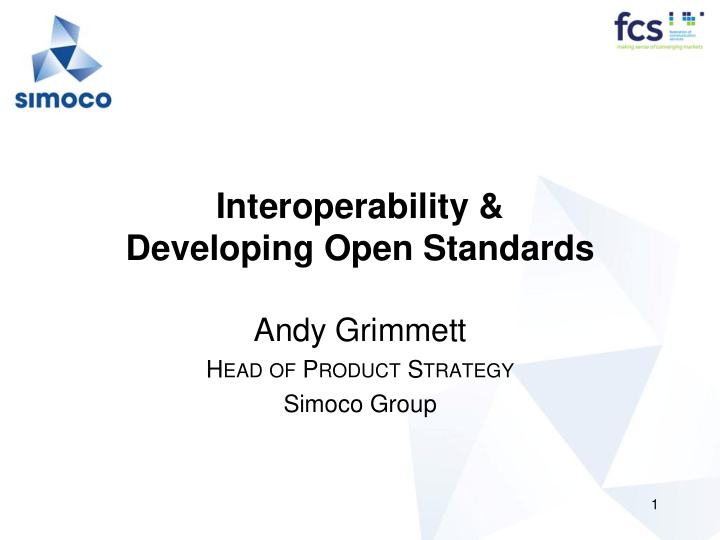



Interoperability & Developing Open Standards Andy Grimmett H EAD OF P RODUCT S TRATEGY Simoco Group 1
Content • Interoperability • Developing Open Standards – Why? – Why? – Levels – What? – Verification – How? – DMR example 2
Interoperability Why? • Provides customers with choice of suppliers • Enables manufacturers to develop a subset of products 3
Interoperability Levels • Air interface • Infrastructure (ISI) • Applications – Terminals – Infrastructure 4
Interoperability Verification £ Independent Bi-lateral with review Bi-lateral Manufacturer Customer Robustness 5
Developing Open Standards Why? • To enable interoperability • PMR longevity – Capital investment – PMR & ancillaries – System lifespan – Private but COTS 6
Open Standards What? – Published specification – Anyone with expertise/resources can implement to realise products – General availability • Free • Purchase specification • Organisation membership fees • Royalty or IPR licensing 7
Open Standard Success How? 1. General availability of the standard 2. Critical mass of suppliers 3. Market demand 8
The Digital PMR Landscape Public Safety Low Cost Digital • TETRA • DMR • P25 • dPMR • NXDN • PDT • e-DMR LTE 9
DMR Example • ETSI Standard • Manufacturer Extensions – MFID • Interoperability – Robustness – Goal of “low cost digital” • Ongoing standards development 10
Criteria for standards success • General availability Freely available of the standard IPR licence • Critical mass of DMRA 84 members suppliers 37 manufacturers • Market demand Analogue migration 11
Development 12
Summary Interoperability Open Standards • Choice • Enables IOP • Robust/Cost • Ensures long term balance supply & support • Transparency • Co-operative enhancements Vendor choice & market cost 13
Thank you www.simocogroup.com 14
Recommend
More recommend